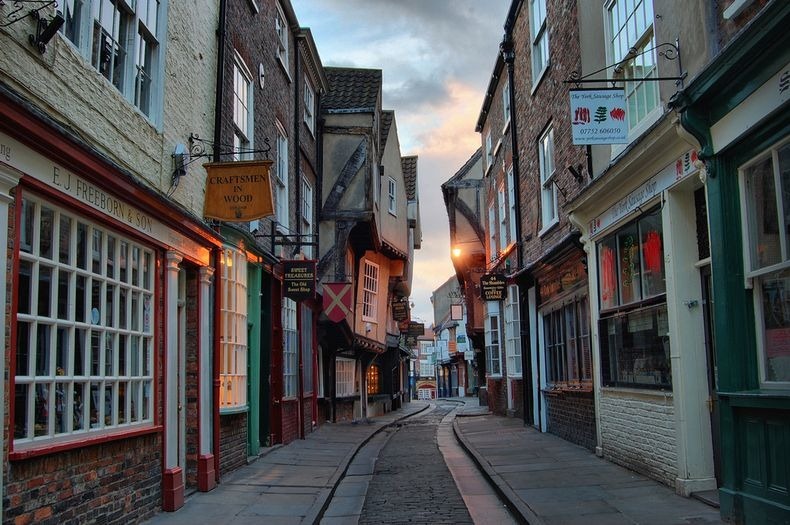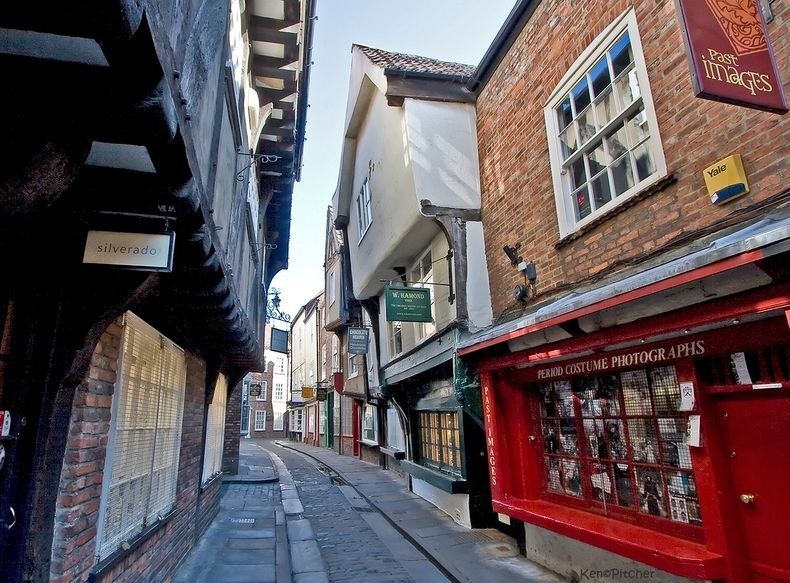The Shambles, York: The Most Medieval Street in England
Located in the heart of the city of York, England, the
Shambles is an old mediaeval street, often called Europe's best
preserved. This short and narrow street has overhanging timber-framed
buildings, some of which dates back as far as the fourteenth century.
The way the buildings lean into the middle of the cobbled street means
that the roofs almost touch each other at the top. In some sections of
the Shambles it is possible to touch both sides of the street with your
arms outstretched. The street is mentioned in the 900 year old “Domesday
book”, making it the oldest and Europe's best preserved medieval
street. The Shambles was once known as “The Great Flesh
Shambles”, probably from the Anglo-Saxon word Fleshammels (literally
'flesh-shelves') - the word for the shelves that butchers used to
display their meat, for it was here that the city's butcher's market was
located. Many houses had slaughterhouse at the back of the premises and
shops at the front. The meat was hung up outside the shops and laid out
for sale on the shop window. It is still possible to see some of the
original butcher’s meat-hooks attached to the shop fronts.

Photo credit
During that period there were no sanitary facilities or hygiene laws as exist today, and guts, offal, and blood were thrown into a runnel down the middle of the street or open space where the butchering was carried out. The pavements were raised either side of the cobbled street to form a channel where the butchers would wash away their offal and blood twice a week.
As recently as 1872 there were twenty-five butchers' shops in the street. The butcher's shops have now been replaced with shops catering to visitors, including jewelry and antiques. The Shambles is now one of the premier shopping areas in the city of York and a popular tourist destination.
In 2010, the Shambles won the award for Britain's Most Picturesque Street by the Google Street Team in an online vote.

Photo credit

Photo credit

Photo credit

Photo credit

Photo credit

Photo credit

Photo credit

Photo credit

Photo credit
Sources: 1, 2, 3, 4
Source consulted: Amusing Planet

Photo credit
During that period there were no sanitary facilities or hygiene laws as exist today, and guts, offal, and blood were thrown into a runnel down the middle of the street or open space where the butchering was carried out. The pavements were raised either side of the cobbled street to form a channel where the butchers would wash away their offal and blood twice a week.
As recently as 1872 there were twenty-five butchers' shops in the street. The butcher's shops have now been replaced with shops catering to visitors, including jewelry and antiques. The Shambles is now one of the premier shopping areas in the city of York and a popular tourist destination.
In 2010, the Shambles won the award for Britain's Most Picturesque Street by the Google Street Team in an online vote.

Photo credit

Photo credit

Photo credit

Photo credit

Photo credit

Photo credit

Photo credit

Photo credit

Photo credit
Sources: 1, 2, 3, 4
Source consulted: Amusing Planet